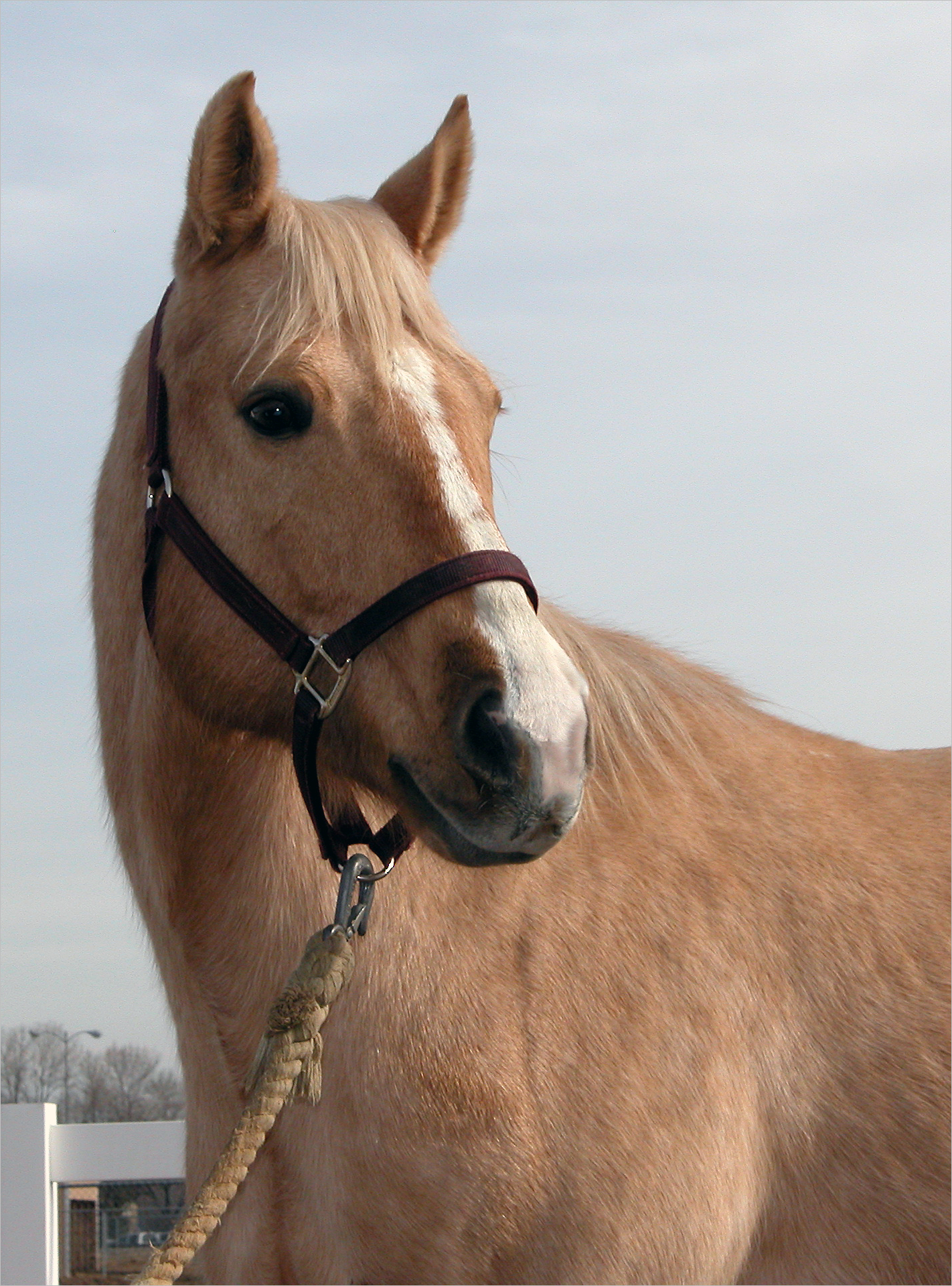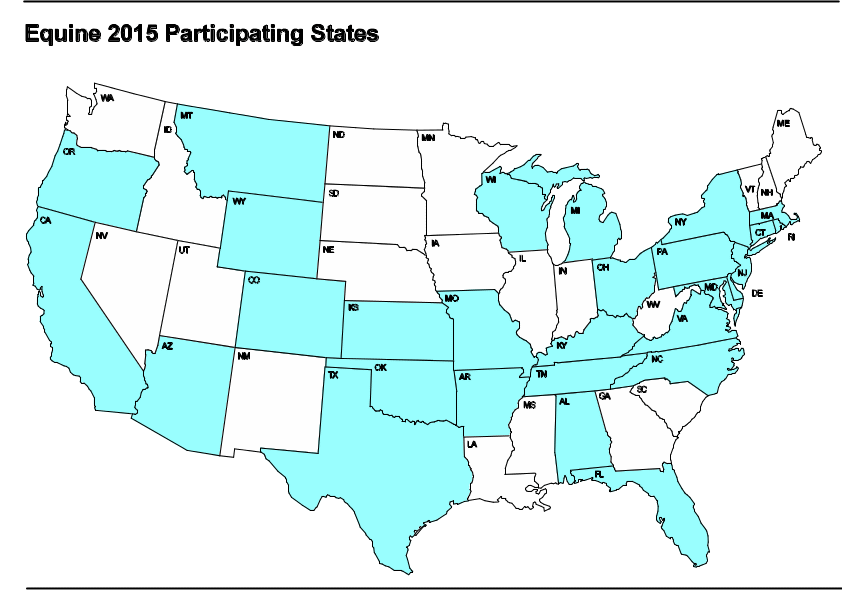NAHMS Equine 2015 Study Info Sheet
NAHMS Equine 2015 Study Info Sheet.doc
Equine 2015 Study
NAHMS Equine 2015 Study Info Sheet
OMB: 0579-0269
![]()
Veterinary Services
Centers for Epidemiology and Animal Health August 2014
_________________________________________________________________________________________________________________________

NAHMS Equine 2015 Study
In July 2015, the U.S. Department of Agriculture’s (USDA) National Animal Health Monitoring System (NAHMS) will launch its third national equine study. Equine 2015 will take an in-depth look at U.S. equine operations and provide the industry with new and valuable information regarding trends in the equine industry from 1998 to 2015.
Study focus
For the study, NAHMS asked equine owners, industry stakeholders, and government officials to provide input and define the information needs of the equine industry. During this process, seven study objectives were identified:
Describe trends in equine care and health management for study years 1998, 2005, and 2015.
Estimate the occurrence of owner-reported lameness and describe practices associated with the management of lameness.
Describe health and management practices associated with important equine infectious diseases.
Describe animal health related costs of equine ownership.
Evaluate control practices for gastrointestinal parasites.
Evaluate horses for presence of ticks and describe tick-control practices used on equine operations.
Collect equine sera along with equine demographic information in order to create a serum bank for future studies.
“Past
NAHMS equine studies have been used as an important resource for
horse owners and all parts of the horse industry. NAHMS Equine
2015 will provide valuable information about disease prevalence and
the impact disease has on horse health. This will help create
awareness, improve horse husbandry to prevent disease, and focus
research on the most important diseases affecting horses, including
evaluating parasite and tick control. I urge all selected horse
owners to participate.”
—Nathaniel
A. White II, DVM, MS Diplomate ACVS
Professor
Emeritus of Equine
Surgery
Marion
duPont Scott Equine Medical Center
Past President of the
American
Association of Equine Practioners
What your participation involves
In July 2015, representatives from the USDA’s National Agricultural Statistics Service (NASS) will contact selected horse owners in 28 States (see map below). NASS representatives will conduct personal interviews with all participating operations that have one or more equids1 and qualify as a farm, as defined by the 2012 Agricultural Census2 conducted by NASS. For operations that choose to continue in the study and are eligible to do so, representatives from USDA’s Veterinary Services will visit from late summer through mid-December 2015 to administer a second questionnaire, collect blood and fecal samples, perform a tick exam, and collect tick specimens.

Benefits of participating in the Equine 2015 study
Participating equine owners will receive:
Customized reports describing animal health information, including enteric parasite status, tick identification, and information regarding how to address and manage health risks.
Best management practices/industry goals.
Information sheets derived from study data.
The equine industry will benefit from:
Current and scientifically valid estimates of management practices, disease prevalence, and other information important for trade and the health of the equine industry (e.g., benchmarking).
Data on trends in the implementation of equine health management practices and the antibiotic susceptibility of selected enteric bacteria.
“By
participating in the NAHMS Equine 2015 study, you’ll be
providing equine population experts with valuable information on
issues such as the prevalence of lameness and how you and other
horse owners treat it, what preventive care practices you consider
most important, and how you control internal parasites.
Ultimately, results from this study will help direct you and other
horse owners in caring for your beloved charges in the best
possible way. I strongly encourage you to participate in this
important study.”
—Stephanie
L. Church
Editor-in-Chief
“The
Horse: Your Guide To Equine Health Care”
and TheHorse.com
A scientific approach
NAHMS collects and reports accurate and useful
information on animal health and management in the
United States. Since 1990, NAHMS has developed
national estimates on disease prevalence and other
factors related to the health of U.S. beef cattle, sheep,
goat, dairy cattle, swine, equids, poultry, and catfish
populations. The science-based results produced by
NAHMS have proven to be of considerable value to the
U.S. livestock, poultry, and aquaculture industries, as
well as other animal health stakeholders.
NAHMS studies are:
National in scope
Science based
Statistically valid
Collaborative
Voluntary
Anonymous
Privacy
Because NAHMS studies rely on voluntary
participation, the privacy of every participant is
protected. Only those collecting the data know the
identity of the respondent. No name or contact
information will be associated with individual data, and
no data will be reported in a way that could reveal the
identity of a participant. Data are presented only in an
aggregate manner.
_____________________
For more information, contact:
USDA–APHIS–VS–CEAH–NAHMS
NRRC Building B, M.S. 2E7
2150 Centre Avenue
Fort Collins, CO 80526-8117
970.494.7000
http://nahms.aphis.usda.gov
#to come
The U.S. Department of Agriculture (USDA) prohibits discrimination in all its programs and activities on the basis of race, color, national origin, age, disability, and where applicable, sex, marital status, familial status, parental status, religion, sexual orientation, genetic information, political beliefs, reprisal, or because all or part of an individual’s income is derived from any public assistance program. (Not all prohibited bases apply to all programs.) Persons with disabilities who require alternative means for communication of program information (Braille, large print, audiotape, etc.) should contact USDA’s TARGET Center at (202) 720–2600 (voice and TDD). To file a complaint of discrimination, write to USDA, Director, Office of Civil Rights, 1400 Independence Avenue, S.W., Washington, D.C. 20250–9410, or call (800) 795–3272 (voice) or (202) 720–6382 (TDD). USDA is an equal opportunity provider and employer.
Mention of companies or commercial products does not imply recommendation or endorsement by the U.S. Department of Agriculture over others not mentioned. USDA neither guarantees nor warrants the standard of any product mentioned. Product names are mentioned solely to report factually on available data and to provide specific information.
1 Horses, ponies, donkeys, mules, and other domestic equine species.
2 The current definition of a farm is a place that could or does actually sell $1,000 of agricultural products annually or that has five or more equids (other than commercial enterprises such as race tracks).
U nited
States Department of Agriculture • Animal and Plant Health
Inspection Service • Safeguarding
American Agriculture
nited
States Department of Agriculture • Animal and Plant Health
Inspection Service • Safeguarding
American Agriculture
| File Type | application/msword |
| Author | bdoty |
| Last Modified By | Quatrano, Christopher B - APHIS |
| File Modified | 2014-08-12 |
| File Created | 2014-08-12 |
© 2025 OMB.report | Privacy Policy